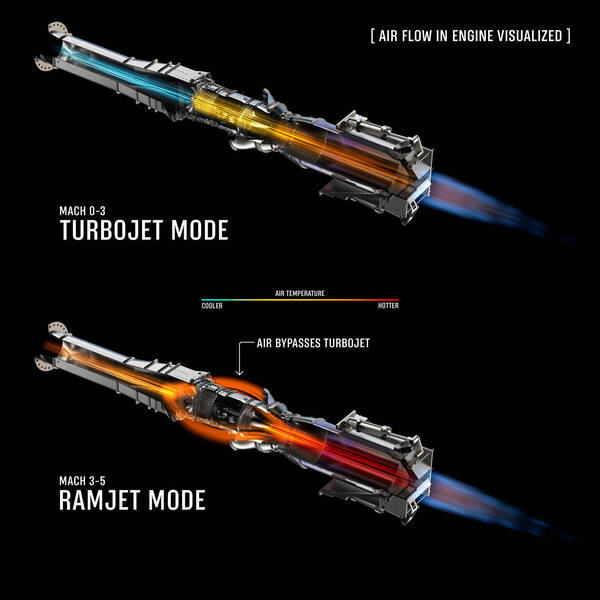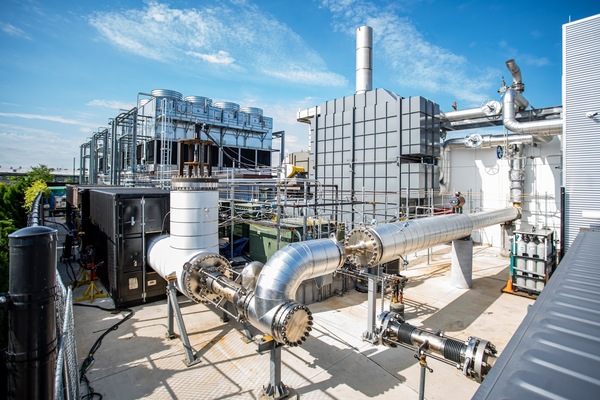In November, the Atlanta-based startup Hermeus reached a milestone in hypersonic flight at a University of Notre Dame research facility.
Just over a year ago, Hermeus approached Notre Dame's Turbomachinery Lab (NDTL) and discussed its plans to develop a Mach 5 commercial aircraft. To support this effort, Hermeus's engineers needed to test the startup's new engine, Chimera.
The engine’s name comes from a "mythical fire-breathing creature with parts taken from various animals," Hermeus says, explaining that the Chimera engine is also "a hybrid." It is a turbine-based combined cycle (TBCC) engine. It can operate as a conventional gas turbine engine or as a ramjet engine. This unique capability allows it to cover an immense range of flight speeds.

Conventional gas turbine engines operate effectively up to Mach 2.3, or 2.3 times the speed of sound. With the addition of an engine pre-cooler, they can reach around Mach 3. Ramjet engines, on the other hand, can reach much higher speeds but only begin to work effectively at speeds approaching Mach 3. A TBCC engine combines the strengths of both types of engines. It operates in gas turbine mode at low Mach numbers and transitions to ramjet mode at high Mach numbers. For this reason, TBCC engines represent a promising solution for creating hypersonic commercial and military aircrafts.
NDTL's task was to help Hermeus demonstrate that Chimera could make the transition from turbojet to ramjet mode. In order to reach this goal, NDTL developed a new testing facility where it could simulate the flight conditions at Chimera's transition point.
Although the NDTL team has extensive experience supporting the development of propulsion systems with its R&D partners, testing Chimera introduced new challenges to overcome. Most previous testing at NDTL had focused on testing engine components—compressors, fans, turbines, and more—individually. To test one of these components, the NDTL team typically connects it to a drivetrain and/or to the facility's air plant to simulate the conditions it would experience while in operation.
To test Chimera, however, the team needed a new facility that would allow them to test the performance of an entire engine. NDTL modified its air plant, extending a supply line to the location of the engine test stand. This supply line was directly connected to the engine intake. This configuration allowed the NDTL team to control the inlet conditions to the engine, simulating flight Mach numbers of up to Mach 4.
To manage the electricity cost associated with operating the air plant and to avoid conflicts with other NDTL programs, the majority of the engine testing occurred in the late evening and early morning hours or over the weekend. It was not unusual for the joint Hermeus and NDTL test team to conduct tests overnight and into the early morning hours.
The tests occurred in bursts. The team would operate the engine for a number of test periods and then stand down to analyze the data and make any required engine hardware and/or control system changes before the next test period.
Another challenge was fuel: Prior to testing Chimera, NDTL did not have experience burning fuel, nor did it have fuel storage facilities. To run the test, the team had to develop new capabilities and infrastructure.
All of these challenges brought out a new level of flexibility, agility, and creativity in both teams.
After five months of testing, the team had operated the Chimera engine over much of the simulated flight envelope. Hermeus announced in November that it had demonstrated the transition from turbojet to ramjet mode, overcoming the key technical challenge of TBCC engines.

“The Notre Dame facility allowed us to create conditions similar to what we’ll see in flight,” said Hermeus co-founder and chief technology officer Glenn Case. “Completing this testing on the ground significantly de-risks our Quarterhorse flight test campaign which will begin late next year.”
NDTL director Joshua Cameron said, “We are pleased that Hermeus chose NDTL as their partner for this exciting test program.” Cameron, who is also a research assistant professor in Notre Dame’s Department of Aerospace and Mechanical Engineering, added, “I am also so proud of my team for developing the facility and executing a successful test campaign on a very aggressive schedule.”
With the learning from this engine test program, Hermeus will continue the technical development of its engine. The NDTL team looks forward Hermeus’s return next year, when it will test a flight-ready version of its Chimera engine.
Contact
Joshua D. Szczudlak / Senior Research Scientist
Notre Dame Turbomachinery Laboratory / University of Notre Dame
ndturbo@nd.edu / +1 574 631 7781 / turbo.nd.edu
About the Notre Dame Turbomachinery Laboratory
NDTL is a University of Notre Dame and South Bend, Indiana-based research and development facility that combines the benefits of a vibrant academic research program with a mid-TRL development and validation test facility serving the aerospace and power generation industries. NDTL’s staff expertise includes internal and external aerodynamics, structural dynamics, instrumentation, combustion, computational fluid dynamics, acoustics, and tribology.
About Notre Dame Research
The University of Notre Dame is a private research and teaching university inspired by its Catholic mission. Located in South Bend, Indiana, its researchers are advancing human understanding through research, scholarship, education, and creative endeavor in order to be a repository for knowledge and a powerful means for doing good in the world. For more information, please see research.nd.edu or @UNDResearch.
Originally published by at turbo.nd.edu on December 19, 2022.